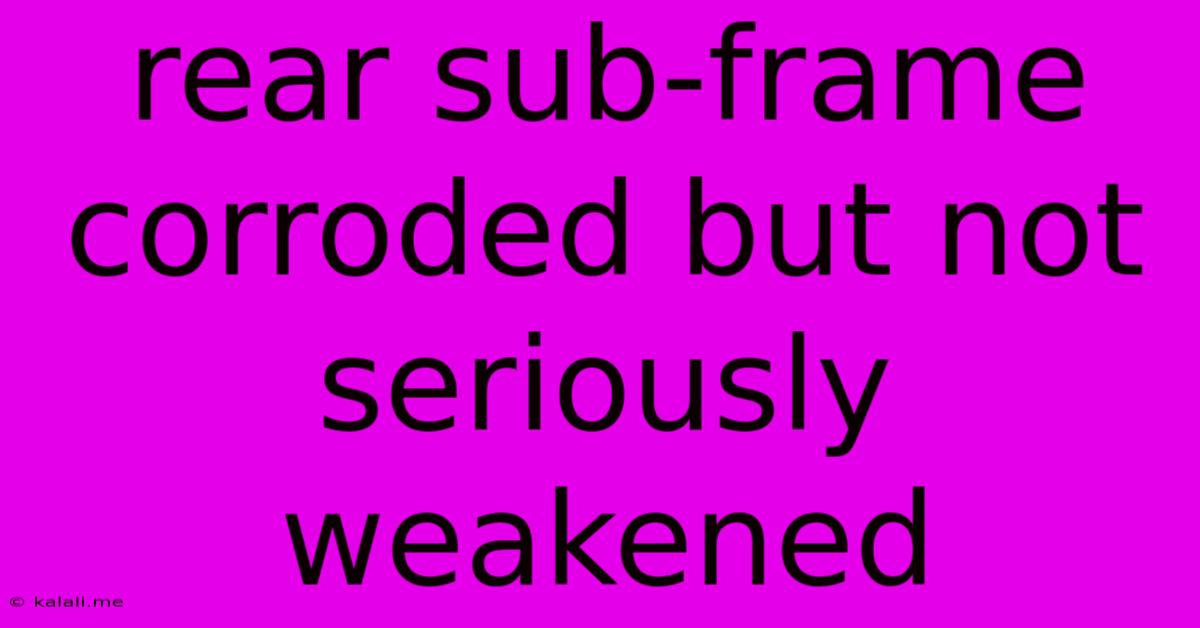Rear Sub-frame Corroded But Not Seriously Weakened
Kalali
May 19, 2025 · 3 min read

Table of Contents
Rear Subframe Corrosion: A Guide to Assessment and Repair
Meta Description: Discovering rear subframe corrosion can be alarming, but not all corrosion requires immediate replacement. This guide helps you assess the damage and determine the best course of action, from minor repairs to complete subframe replacement.
Rear subframe corrosion is a common problem, particularly in vehicles exposed to harsh weather conditions like salt spray or frequent rain. While the discovery of rust can be unsettling, it's crucial to understand that not all corroded subframes require immediate replacement. The severity of the damage dictates the necessary repair strategy. This article will guide you through assessing the extent of the corrosion and deciding on the appropriate course of action.
Assessing the Damage: Beyond Surface Rust
The first step is a thorough inspection of the rear subframe. This involves carefully examining all accessible areas for signs of corrosion. Look for:
- Surface rust: This is the least concerning type of corrosion. It's typically characterized by a reddish-brown discoloration and can often be removed with wire brushing and appropriate rust treatment.
- Pitting: Small holes or depressions in the metal indicate more serious corrosion. The depth and extent of pitting should be carefully assessed. Shallow pitting might be manageable, while deep pitting could compromise structural integrity.
- Through-rust: This is the most serious type of corrosion, where rust has penetrated the entire thickness of the metal, creating holes. This significantly weakens the subframe and requires immediate attention.
- Cracking: Cracks in the subframe, especially near weld points or stress points, are a critical concern and often necessitate a replacement.
Use a flashlight and a mirror to reach those hard-to-see areas. If you're unsure about the extent of the damage, it's always best to consult a qualified mechanic. They can provide a professional assessment and recommend the best approach.
Repairing Minor Corrosion: A Cost-Effective Solution
If the corrosion is limited to surface rust and minor pitting, repairs can be relatively straightforward and cost-effective. This typically involves:
- Cleaning: Thoroughly clean the affected area with a wire brush to remove loose rust and debris.
- Rust treatment: Apply a rust converter to neutralize the remaining rust and provide a stable base for paint.
- Primer and paint: Apply a suitable primer followed by several coats of paint to protect the metal from further corrosion.
Important Note: Ensure proper surface preparation before applying any coatings for optimal adhesion and longevity.
When Replacement is Necessary: Prioritizing Safety
If the corrosion is severe, involving through-rust, deep pitting, or cracking, subframe replacement is often the safest and most reliable option. A weakened subframe can compromise the vehicle's structural integrity, potentially leading to dangerous handling characteristics. This is especially critical for safety-sensitive components like mounting points for suspension, braking system, or the fuel tank.
Replacing a rear subframe is a complex repair job and typically requires professional expertise. It involves carefully removing the old subframe, installing the new one, and ensuring proper alignment and secure fastening.
Prevention is Key: Long-Term Strategies
Preventing rear subframe corrosion is far easier and more cost-effective than repairing it. Regularly inspect your vehicle's undercarriage, paying close attention to areas prone to rust. Consider:
- Undercoating: Applying undercoating to protect vulnerable areas from moisture and road salt.
- Regular washing: Washing the undercarriage regularly to remove road salt and debris.
- Immediate repair of minor damage: Addressing small areas of rust promptly before they have a chance to spread.
By following these guidelines, you can effectively assess the condition of your rear subframe, determine the appropriate course of action, and ultimately ensure the safety and longevity of your vehicle. Remember, when in doubt, always consult a qualified mechanic. Their expertise can provide peace of mind and ensure your vehicle remains roadworthy and safe.
Latest Posts
Latest Posts
-
Play It By Ear Or Year
May 19, 2025
-
I Look Forward In Meeting You
May 19, 2025
-
Now U See Me Now U Dont
May 19, 2025
-
How Many Pages In A Chapter
May 19, 2025
-
How To Get More Dwellers Fallout Shelter
May 19, 2025
Related Post
Thank you for visiting our website which covers about Rear Sub-frame Corroded But Not Seriously Weakened . We hope the information provided has been useful to you. Feel free to contact us if you have any questions or need further assistance. See you next time and don't miss to bookmark.